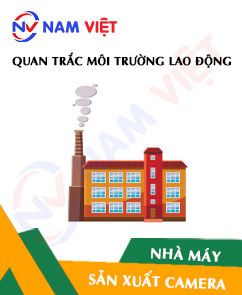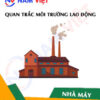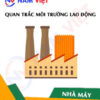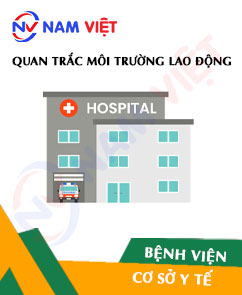Occupational Environment Monitoring at Camera Manufacturing Factory
99,000 ₫
Note: The above price is calculated for one sample, the price may vary depending on the area of the environment to be monitored and the fluctuations of the market. For more accurate price support, please refer to the quotation table or contact our consulting staff directly.
Environmental monitoring of the camera manufacturing factory is a session of collecting, analyzing, and evaluating workplace factors that may harm workers’ health.
Table of Contents
Toggle1. Overview of camera manufacturing factory
a. What is a camera manufacturing factory?
Factory manufactures cameras is a production facility where cameras and surveillance systems are mass-produced. This factory specializes in manufacturing security cameras, surveillance cameras, dash cams, photography cameras, and other related devices.
Camera manufacturing factories often use modern technologies and automated machinery to increase productivity and accuracy during production. Embedded technology, imaging technology, and wireless communication technology are also applied in camera manufacturing to meet the increasing demand of the market.
These factories typically apply strict quality control processes to ensure that the final product meets standards and quality requirements. This includes inspection of input components, production processes, and final quality checks before packaging and delivery.

b. Production stages in a camera manufacturing factory
The production stages in a camera manufacturing factory may include the following steps:
- Component processing: Small components of cameras are processed from materials such as metal, plastic, microchips, lenses, and other electronic components. This stage usually involves cutting, grinding, turning, molding, and other processes to create precise components that meet design specifications.
- Assembly: After processing, components are assembled into a complete device. Workers typically use tools and machinery to assemble components, including wiring connections, attaching lenses, adjusting mechanical structures, and processors.
- Quality inspection: After assembly, cameras are tested to ensure they function properly and meet quality standards. Inspections may include image testing, functional testing, measuring technical specifications, and durability tests.
- Configuration and final testing: Before packaging, cameras need to be configured with various settings and options, such as resolution, viewing angle, operation modes, and network settings. Afterwards, cameras undergo final testing to ensure accuracy and compliance with technical requirements.
- Packaging and delivery: After final inspection, cameras are packaged in boxes and prepared for shipment. Packaging includes careful wrapping, labeling, providing user manuals, and protective packaging to ensure the products are not damaged during transportation.

c. Types of machinery used in a camera manufacturing factory
In a camera manufacturing factory, many types of machines and equipment are used for production stages. Below are some common machines used in camera production:
- CNC lathe: Used to process metal components of cameras such as housings, lenses, and other parts. CNC lathes operate automatically based on programmed numerical control, ensuring high precision and increased productivity.
- Glass pressing machine: Used to press and secure protective glass on the front of cameras. The glass pressing machine can adjust pressure and temperature to ensure the glass is firmly attached without deformation.
- Electronic soldering machine: Used for soldering and connecting electronic components such as processors, sensors, and circuits inside cameras. Electronic soldering machines often have reliability testing functions for soldered connections.
- Testing and calibration machines: Used to test and calibrate technical specifications of cameras such as resolution, light sensitivity, white balance, viewing angles, and other functions. These machines ensure quality and compliance with product standards.
- Automatic assembly machines: Used to assemble components and modules into the camera housing. These machines perform fast and precise assembly steps, improving productivity and reducing human errors.
- Printing and packaging machines: Used to print labels and barcodes on camera products, package them into boxes, and apply product labels. These machines ensure products are securely packaged with complete information.

d. Occupational diseases workers in camera manufacturing factories may encounter
Workers in camera manufacturing factories may suffer from some occupational diseases, depending on workplace environmental factors and specific production processes. Below are some common occupational diseases:
- Nervous system diseases: Long-term exposure to toxic chemicals can cause nervous system issues such as headaches, dizziness, insomnia, memory loss, and even nerve damage.
- Respiratory diseases: Dust, chemical fumes, or toxic gases in the production process can irritate or damage the respiratory tract, leading to issues such as pneumonia, asthma, or occupational lung disease.
- Skin diseases: Exposure to chemicals during production, such as solvents, can cause skin irritation, dermatitis, eczema, and other conditions.
- Vision problems: Work involving telecommunications and assembling small details may cause eye strain, fatigue, and other vision-related problems.
- Hearing problems: Noise from machinery and tools during production can damage hearing, leading to hearing loss, tinnitus, and occupational ear diseases.
To prevent occupational diseases, camera manufacturing factories must comply with regulations on occupational safety and working environments. This includes providing personal protective equipment, ensuring good ventilation, controlling noise and harmful agents, offering safety training and risk management, and implementing measures to reduce exposure to toxic substances.

e. Popular types of cameras on the market
There are many types of cameras available on the market, each serving different purposes and applications. Some popular types include:
- Security cameras: Used to monitor and record images and videos in security systems such as homes, companies, stores, schools, parking lots, and other public areas.
- Surveillance cameras: Used in industrial monitoring systems, such as in factories, workshops, power stations, and other workplaces to oversee production processes and worker safety.
- Traffic cameras: Used in traffic systems to monitor and record images and videos of streets, traffic signals, and other routes to support traffic management and violation handling.
- Dash cameras: Installed in cars, motorcycles, and other vehicles to record images and videos while driving, aiding in investigations and providing evidence in traffic accidents.
- Sports cameras: Used to record images and videos during sports and adventure activities such as hiking, climbing, surfing, and other sports.
- Virtual reality cameras (VR): Used to capture and transmit images and videos for virtual reality experiences, creating unique virtual environments for users.
- Mobile phone cameras: Nowadays, most mobile phones are equipped with cameras for photography and video recording.
2. Overview of occupational environment monitoring services
a. What is occupational environment monitoring in a camera manufacturing factory?
Occupational environment monitoring (or workplace environment measurement) in a camera manufacturing factory involves collecting, assessing, and analyzing indicators of workplace environmental factors in the factory, in order to take timely measures to reduce environmental harm to workers’ health and prevent occupational diseases. Occupational environment monitoring is a mandatory requirement for camera manufacturing factories.
Occupational environment monitoring plays a vital role in caring for, protecting, and improving workers’ health, as employees are the main resource of businesses and directly create profits. Workers frequently exposed to hazardous factors exceeding permissible standards will have their health affected and may develop occupational diseases.
REGISTER FOR OCCUPATIONAL ENVIRONMENT MONITORING SERVICE
b. Occupational environment monitoring program of Nam Viet
The occupational environment monitoring program of Nam Viet is a program developed by monitoring engineers in occupational safety and environmental protection. With the goal of ensuring health and safety for workers, this program uses modern measurement methods to monitor air quality, water, microclimate factors, physics, dust, etc. in the workplace. This program plays a critical role in ensuring a safe working environment and protecting workers’ health.
In addition, Nam Viet’s occupational environment monitoring program is important for researching and developing new solutions to improve workplace environmental quality. With the dedication and professionalism of the monitoring experts, Nam Viet’s exclusive monitoring program is becoming a breakthrough in labor safety management and environmental protection in Vietnam.

c. Standardization in workplace environment measurement processes
The standardization in occupational environment measurement processes of Nam Viet is a crucial aspect in ensuring result accuracy. To guarantee accuracy and reliability of measurement results, this program uses standardized procedures recognized by Ho Chi Minh City Department of Health. This ensures that collected data is highly reliable for workplace assessments and decision-making on improvements to protect workers’ health.
These standardized processes also ensure results are carried out by monitoring specialists with high qualifications and years of experience, allowing managers and experts to trust results from An Toan Nam Viet and make accurate, valuable decisions for protecting workers’ health and the environment.
With the application of standardization in occupational environment measurement, Nam Viet demonstrates its commitment to ensuring safe workplaces and protecting workers’ health, while positively contributing to the development and improvement of occupational safety management and environmental protection in Vietnam.
d. Monitoring report results in camera manufacturing factories
Occupational environment monitoring results are prepared according to form number 04, Appendix III issued with Decree 44/2016/ND-CP and made into 02 copies: 01 copy sent to the labor facility that signed the monitoring contract and 01 copy kept at the monitoring organization.
The retention period of occupational environment monitoring results is indefinite according to legal regulations.

e. Frequency of occupational environment monitoring according to the law
According to Clause 2 of Article 18 of the Occupational Safety and Hygiene Law 84/2015/QH13, employers must organize occupational environment monitoring to assess harmful factors at least once a year.
f. Deadline for submitting occupational environment monitoring reports according to the law
The submission deadline is before December 31 each year. Enterprises belonging to production facilities must submit occupational environment monitoring reports to the local Department of Health where their headquarters and workplaces are located.
When there are changes in technology, production processes, or during renovation and upgrading of labor facilities that may generate new harmful factors affecting workers’ health, enterprises in production facilities must update occupational hygiene records related to harmful factors that require occupational environment monitoring.
g. Regulations on penalties for violations of occupational environment monitoring by employers
According to Article 27 of Decree No. 12/2022/ND-CP dated January 17, 2022, on administrative penalties in labor, social insurance, and Vietnamese workers working abroad under contracts:
- Clause 2: A fine of 2,000,000 – 5,000,000 VND for employers who fail to publicly announce to employees at occupational environment monitoring sites and places where hazard assessment, inspection, and management are conducted immediately after obtaining monitoring results.
- Clause 3: A fine of 20,000,000 – 40,000,000 VND for employers who fail to conduct occupational environment monitoring to control harmful effects on workers’ health as required by law.
- Clause 4: A fine of 40,000,000 – 60,000,000 VND for employers who collude with monitoring organizations to commit fraud in occupational environment monitoring activities, but not to the extent of criminal liability.
3. Harmful Environmental Factors for Workers in Camera Manufacturing Plants
There are several environmental factors that can be harmful to workers in camera manufacturing plants. Below are some potential environmental factors that may affect workers’ health:
- Dust and fine particles: The camera manufacturing process can generate dust and fine particles from materials, machining, and processing. Inhaling dust and fine particles may cause respiratory irritation, pneumonia, and other respiratory health problems.
- Chemicals: During camera manufacturing, chemicals such as solvents, cleaning agents, adhesives, and coatings may be used. Exposure to these substances may cause skin irritation, dermatitis, allergies, and may pose risks to the nervous system and internal organs.
- Noise: Machinery and equipment in camera manufacturing plants can generate loud noise. Continuous and prolonged noise exposure may cause stress, insomnia, reduced concentration, and potential hearing damage.
- Lighting: Camera manufacturing plants often use strong lighting for inspection and quality control. Prolonged exposure to intense lighting may cause eye strain, discomfort, and potential eye damage.
- Temperature and humidity: The working environment in camera manufacturing plants may have unstable temperature and humidity levels. Excessive heat or cold, along with unsuitable humidity, may cause discomfort, fatigue, and affect workers’ health and performance.
- Electromagnetic exposure: During the camera production process, there may be electromagnetic effects from electronic devices and machinery. Prolonged exposure to electromagnetic fields may cause fatigue, stress, and affect the workers’ nervous system.
REGISTER FOR OCCUPATIONAL ENVIRONMENT MONITORING SERVICE
4. Measures to Improve the Working Environment in Camera Manufacturing Plants
To improve the working environment in camera manufacturing plants and protect workers’ health, the following measures can be applied:
- Dust and fine particle control: Ensure effective dust extraction systems and regularly clean work areas to reduce dust and fine particle accumulation.
- Safe use of chemicals: Select and use chemicals that are not harmful to workers’ health. Ensure proper storage and usage of chemicals in compliance with safety regulations and guidelines.
- Noise control: Provide workers with hearing protection equipment and apply soundproofing or insulation measures to reduce noise at its source.
- Lighting: Ensure proper natural or artificial lighting in work areas. Use lamps with good light quality and avoid direct exposure to intense lighting.
- Temperature and humidity control: Maintain stable and comfortable temperature and humidity levels in the workplace. Use air conditioning systems, ventilation fans, and ensure proper airflow in work areas.
- Training and education: Provide workers with training and guidance on safe working procedures, environmental protection regulations, and the correct use of personal protective equipment.
- Risk management: Assess and manage risks during production, ensure compliance with safety regulations and procedures, and implement preventive measures to minimize risks to workers.
- Periodically organize occupational environment monitoring in factories, collect and analyze harmful factors for workers, and adjust to reduce hazards in order to prevent occupational diseases.
5. Benefits of Periodic Monitoring in Camera Manufacturing Plants
An Toan Nam Viet provides enterprises with excellent benefits when using occupational environment monitoring services in compliance with Decree 44/2016/ND-CP on the management and control of harmful factors in the working environment that affect workers.
- Enterprises can actively control harmful factors in workshops or factories.
- Receive consulting and recommendations for measures to minimize harmful factors and improve the quality of the working environment.
- Indirectly protect human resources, the key factor in business development.
- Reduce the harmful impacts of occupational diseases on workers’ health, thereby minimizing future treatment costs.
- Improve workers’ health, which enhances product quality as well as ensures and maintains productivity.
- Comply with occupational safety regulations, avoiding legal risks.
- Create credibility and professionalism in all aspects, thereby elevating the enterprise’s brand value.
Nam Viet’s environmental monitoring service is the solution to minimize the harmful effects of occupational diseases, contributing to a healthy and high-quality working environment.

6. National Occupational Environment Monitoring Center
Occupational Environment Monitoring Center of Nam Viet is a professional unit specializing in monitoring and measuring the quality of the working environment nationwide across all provinces and cities in Vietnam. With a team of experienced monitoring specialists, the center uses modern measuring equipment, ensuring accuracy and reliability.
In addition to providing monitoring services, the center also supports clients in planning, handling, and monitoring occupational environment issues. With the motto “customers are the center,” the center prioritizes customer satisfaction, meets every client’s need, and is committed to delivering the best solutions for enterprises.
REGISTER FOR OCCUPATIONAL ENVIRONMENT MONITORING SERVICE
With investments in technology, equipment, and human resources, Nam Viet’s monitoring center has become one of the most reputable units in the field of occupational environment monitoring in Ho Chi Minh City, with the following objectives:
- We always value our brand reputation and the quality of our services.
- We provide clients with the best and most suitable solutions possible.
- Along with a team of experienced Masters and Engineers, we aim to protect the environment and bring benefits to enterprises.
- By working with Nam Viet’s Occupational Environment Monitoring team, companies will receive professional service from monitoring experts and the best cost-saving benefits.
The occupational environment monitoring process at Nam Viet includes the following basic steps:
- Before carrying out occupational environment monitoring, our company ensures that all monitoring equipment is adjusted and calibrated in compliance with legal regulations.
- Fully and properly perform the occupational environment monitoring process as committed to the Department of Health.
- Accurately report monitoring results to employers.
- In cases where monitoring results show unsafe working conditions for workers, Nam Viet will support with corrective solutions, and the workplace will implement the following:
- Implement measures to improve working conditions to minimize harmful factors and prevent occupational diseases.
- Organize medical checkups to detect early occupational diseases and work-related illnesses for workers in unsafe environments.
- Provide workers with allowances in kind as stipulated by labor law.

7. Occupational Environment Monitoring Service Price Quotation
To help enterprises carry out occupational environment monitoring professionally and effectively, Nam Viet provides clients with a detailed service quotation for occupational environment monitoring at reasonable costs.
- Our quotation provides detailed information on the prices of monitoring services we currently offer, including costs related to transportation, measurement, analysis, and reporting. Clients can rest assured of the accuracy and reliability of the monitoring reports we provide.
- We are committed to offering the most competitive and reasonable prices in the market, and we are always ready to provide fast and professional consultation to answer all inquiries regarding monitoring services.
- With Nam Viet’s service quotation, clients can easily select service packages suitable for their needs. We are committed to delivering the highest level of customer satisfaction with professional service quality.
No comments yet












Review Occupational Environment Monitoring at Camera Manufacturing Factory
There are no reviews yet.